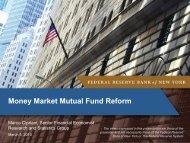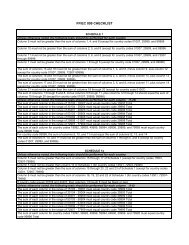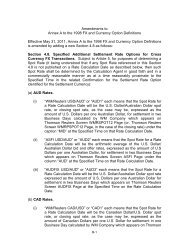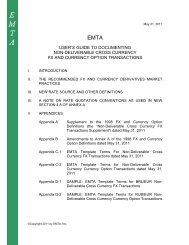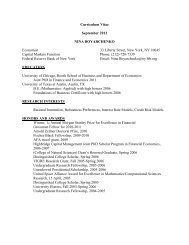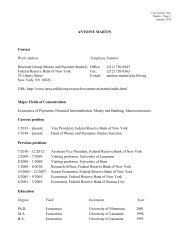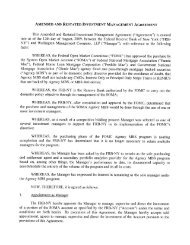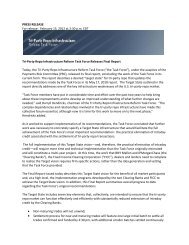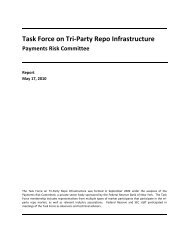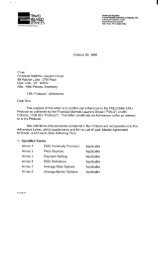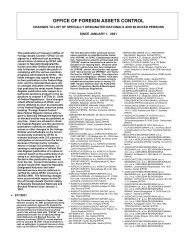Residential Foreclosures in the City of Buffalo, 1990-2000 - Federal ...
Residential Foreclosures in the City of Buffalo, 1990-2000 - Federal ...
Residential Foreclosures in the City of Buffalo, 1990-2000 - Federal ...
You also want an ePaper? Increase the reach of your titles
YUMPU automatically turns print PDFs into web optimized ePapers that Google loves.
Table 13<br />
Percentage <strong>of</strong> Foreclosed Loans Orig<strong>in</strong>ated<br />
by HUD-Designated Subprime Lenders<br />
Community<br />
All Loans<br />
Orig<strong>in</strong>ated by<br />
Subprime Lenders Purchase Ref<strong>in</strong>ance<br />
Ellicott-Masten 45 10 31<br />
East Side 36 11 25<br />
East Delavan 24 9 15<br />
South <strong>Buffalo</strong>-River 21 3 17<br />
North <strong>Buffalo</strong>-Elmwood 15 0 15<br />
West Side-Central 15 6 9<br />
Riverside 14 14 0<br />
North East 11 5 4<br />
<strong>Buffalo</strong> total 21 7 14<br />
Sources: Erie County Civil Court records; Erie County property database;<br />
U.S. Department <strong>of</strong> Hous<strong>in</strong>g and Urban Development (HUD);<br />
author's calculations.<br />
By comparison, <strong>the</strong> 1998 Rochester study found that just 8 percent <strong>of</strong> foreclosures<br />
were associated with subprime lenders. The difference could be attributable to <strong>the</strong> tim<strong>in</strong>g<br />
<strong>of</strong> <strong>the</strong> two studies. Because <strong>the</strong> growth <strong>in</strong> subprime lend<strong>in</strong>g is a recent occurrence, <strong>the</strong><br />
impact on foreclosures may have been greater <strong>in</strong> <strong>2000</strong> than <strong>in</strong> 1998. However, evidence<br />
suggests that subprime lend<strong>in</strong>g is more common <strong>in</strong> <strong>Buffalo</strong> than <strong>in</strong> Rochester, at least<br />
among blacks. One study found that <strong>in</strong> <strong>2000</strong>, almost 75 percent <strong>of</strong> conventional ref<strong>in</strong>ance<br />
loans to blacks <strong>in</strong> <strong>the</strong> <strong>Buffalo</strong>-Niagara metro area were orig<strong>in</strong>ated by subprime lenders,<br />
compared with only 45 percent <strong>in</strong> <strong>the</strong> Rochester metro area. 11<br />
In our study, two <strong>Buffalo</strong> communities exhibited an exceptionally high share <strong>of</strong><br />
foreclosed loans orig<strong>in</strong>ated by subprime lenders: Ellicott-Masten, 45 percent, and East<br />
Side, 36 percent. Both communities are lower <strong>in</strong>come and have a high concentration <strong>of</strong><br />
m<strong>in</strong>orities. Also, <strong>in</strong> both <strong>in</strong>stances, ref<strong>in</strong>ance loans by subprime lenders were by far <strong>the</strong><br />
most prevalent. Subprime lend<strong>in</strong>g was dom<strong>in</strong>ated by ref<strong>in</strong>ance loans <strong>in</strong> most <strong>Buffalo</strong><br />
neighborhoods. Riverside, however, proved <strong>the</strong> exception: all foreclosed loans orig<strong>in</strong>ated<br />
by subprime lenders were for a purchase. Table 13 <strong>in</strong>dicates that <strong>the</strong> overall <strong>in</strong>cidence <strong>of</strong><br />
subprime foreclosures varied widely among <strong>Buffalo</strong>’s communities.<br />
11 Bradford, 2002, pp. 38-9.<br />
47



